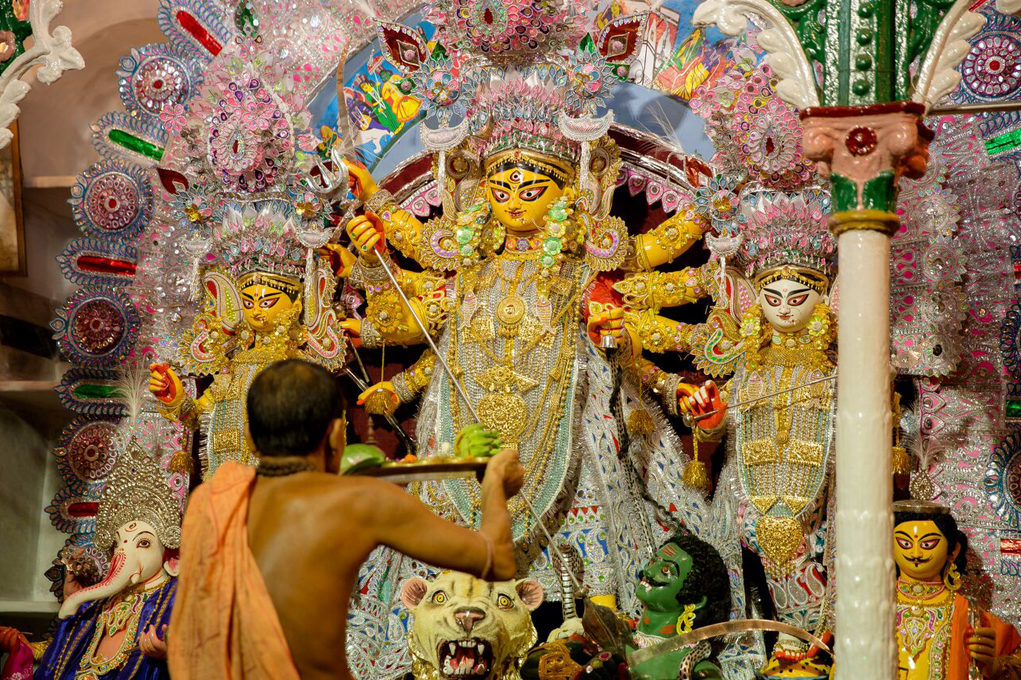‘Old Kolkata Pujo’! What’s that anyway? With more and more tour operators pressing into action during the Puja days in Kolkata, peculiar expressions like this have entered the Pujo parlance. A tour like this involves, quite invariably, a quick look at the Pujo premises of the Debs of Sovabazar, the Duttas of Hatkhola, the Sarkars of Beadon Street, Basu Mallicks of Pataldanga and a few other houses of distinction.
Since a television channel has serialized the life and times of Rani Rasmani, the Das residence of Janbazar has shot up to the top of the wish list. Although a pale shadow of their haloed past and surrounded by rows of small time shops peddling all sort of household supplies, the Janbazar houses of the Das family have retained some of the uniqueness that marked their beginning in the late 18th century. Unlike some other houses the Das family has splintered into pieces. Some of the splinters do not have the means to worship the Mother Goddess. A chance visit to any of the houses on the stretch along both the sides of S N Banerjee Road, will reveal a world bygone.
The marble plaques, the in-lay works executed in precious gem stones are still there to be seen. If one manages to peep in now, one would find an image maker working round the clock to meet the deadline. The Das family never relied on dices. The face of the Goddess is refashioned every year. However, the look is the same, family members would tell you. And the colour will remind you of the seuli blossoms that lined the Janbazar streets those days.
Although Janbazar, the name, remains in everyday use, most of the city dwellers have no idea about Hatkhola. Well, to cut the long story short, Job Charnock landed at this market on 24 August 1690. The urbanization of colonial Calcutta started here. Jagatram Dutta, an influential diwan with the Patna Warehouse of East India Company amassed such a fortune that he shifted their Chitpur house to Hatkhola by erecting a palatial mansion almost a furlong along the northern end of Nimtolla Ghat Street. The Thakurdalan is tucked within a narrow urban courtyard that could be negotiated through a narrower gate that has not seen any maintenance for decades. One should go there to realize how Jagatram’s successors failed to keep up with the times, how many of the north Kolkata houses failed to reinvent themselves. The houses that are open to all during the festive occasions have many sorry tales to share.
A hit and run visit will not yield much result but patient visits and revisits surely do. Each Pujo has norms laid out for centuries and each Pujo is unique in terms of rituals. Slightest of deviations from the ‘tradition’ is considered blasphemous by most. Most have generations of family priests who have been performing the rituals for centuries. Most have customized idols crafted in their thakurdalan.
There is hardly anybody to guide if one enters one of these private worlds. The Sarkar mansion on 67E Beadon Street is better known as Chhatubabu-Latubabur Bari. One will marvel at the idol. Durga is not accompanied by any of her children, but chaperoned by Jaya and Vijaya, her consorts! If one manages to check inside the Mullick mansion of Pathuriaghata on 32 Darpanarayan Street, the eyebrows will twitch at the sight of the goddess cozily seated on the lap of Shiva! Surprises such as these are galore in the old houses of Kolkata.
The vast urban courtyard of the Deb mansions may look tidy at first. The green terrace may betray some signs of care. The fresh coat of white on the walls will surely deflect one’s attention from the hanging verandas that crumbled decades back. The tiny cannon, supposedly a trophy from the battlefield of Plassey is so engaging that one will not care to look up and explore the jalsaghar which hosted some of the most lavish parties that 18th and 19th century Kolkata could dream of.
Nineteenth century Kolkata spawned one idyllic proverb about Durga Pujo: “On her arrival in Calcutta, Maa decks up with the ornaments at Shibkrishna Dawn’s residence in Jorasanko, feasts at Abhaycharan Mitra’s residence in Kumartuli and the dances at Sovabazar Rajbari keeps her awake all through the night!” Those days are all but gone!
Only the Dawns on 12 Shibkrishna Dawn Lane have managed to stem the tide in some way. If urban legends are to be believed the Dawns, who run gun shops at Chowringhee these days, were so compatible with the European merchants in the first half of 19th century that in one particular year Shibkrishna imported precious ornaments studded with diamond and emerald from a Parisian jeweller. They must have cost a fortune. It was prudent for him to remove those precious ornaments before the immersion. The news reached the Tagore mansion in Jorasanko in no time. Dwarakanath, who must have seethed in frustration, took note and ordered immersion of the Tagore house idol with golden ornaments on!
One can always consult Kaliprasanna Sinha’s Hutom Pyachar Naksha for some authentic description of Pujo festivities that often ended up into a cock fight between several factions of Hindu families of power. All the city dwellers hankered for a printed invitation card from them. Cards are still printed in some of the houses. But the doors are open for all and sundry. Only the food remains a family preserve. Prepared on one corner of the thakurdalan, the sight of over-sized sweetmeats and luchis is one element that separates the plebeians from the elites.
[Cover picture: Shibkrishna Dawn’s Puja]


Comments are closed.